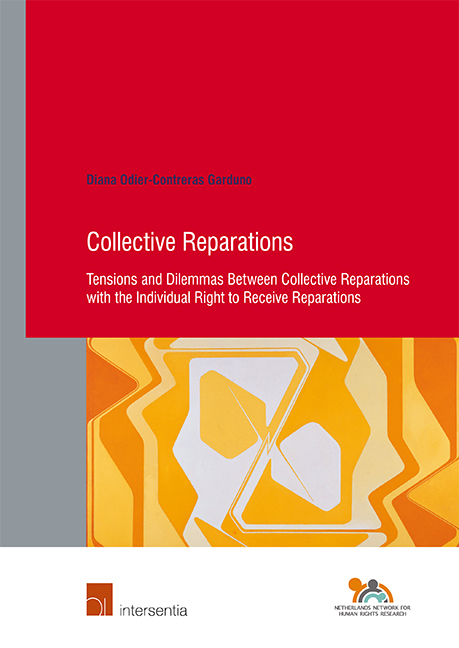 Collective Reparations
Collective Reparations Book contents
- Frontmatter
- Acknowledgments
- Table of Contents
- Abbreviations
- Chapter I Introduction
- Chapter II Developments Concerning the Right to Reparation
- Chapter III Collective Reparations at the Inter-American Court of Human Rights
- Chapter IV Collective Reparations in International Criminal Law
- Chapter V Collective Reparations & Non-Judicial Bodies
- Chapter VI Conclusions
- Samenvatting
- Resumen
- Résumé
- Bibliography
- Table of Instruments
- Table of Cases, Decisions and Filings
- Curriculum Vitae
- Human Rights Research Series
Chapter V - Collective Reparations & Non-Judicial Bodies
Published online by Cambridge University Press: 31 January 2019
- Frontmatter
- Acknowledgments
- Table of Contents
- Abbreviations
- Chapter I Introduction
- Chapter II Developments Concerning the Right to Reparation
- Chapter III Collective Reparations at the Inter-American Court of Human Rights
- Chapter IV Collective Reparations in International Criminal Law
- Chapter V Collective Reparations & Non-Judicial Bodies
- Chapter VI Conclusions
- Samenvatting
- Resumen
- Résumé
- Bibliography
- Table of Instruments
- Table of Cases, Decisions and Filings
- Curriculum Vitae
- Human Rights Research Series
Summary
Introduction
Collective reparations first emerged within the context of societies in transition: societies that have experienced either severe (internal) violent conflicts or authoritarian regimes that produced grave violations of human rights (GVHR) such as those that are protected under international human rights law and, in some cases, under international humanitarian law. These societies strive to deal with those past legacies while moving forward towards more democratic orders. Although Tomuschat has submitted that in ‘any process of transitional justice, the primary goal must be to re-establish security and respect for human rights as a matter of collective reparation’, thereby reducing reparations to the democratic ‘transition itself’, societies usually seek to provide reparations to the victims of past crimes through reparation programmes to facilitate such a transition and to bolster reconciliation processes.
Reparations have become a ‘leading response’ in transitional justice processes (TJPs), because they convey a message that the harm suffered is acknowledged and an attempt is being made to make amends for this harm. Their importance is underscored by the fact that even the involvement of the United Nations Security Council (UNSC) in post-conflict situations includes the establishment of a sui generis mechanism of collective claims programmes to contribute to reconciliation.
Although not necessarily exclusively, reparations as part of a TJP consist of collective reparations and most commonly focus on providing in-kind benefits such as medical or educational services as well as symbolic and satisfaction measures including apologies, monuments, or minimal financial awards. Reparations are usually demanded or established by Truth and Reconciliation Commissions (TRCs), but they can also emerge from national initiatives, often demanded by civil society. Alternatively, they may be provided by different non-judicial bodies.
This chapter will provide a comparative analysis of collective reparations as part of transitional justice mechanisms, with the aim of identifying similarities and differences among the substantive and procedural aspects of those reparations recommended or designed by different non-judicial bodies. The chapter commences by providing a definition of transitional justice and its most common mechanisms, as well as by commenting on the emergence of collective reparation programmes. Next, in-depth case studies will be discussed regarding the collective reparations recommended by the TRCs in Peru and Morocco. Both TRCs were a response to victims from oppressive government regimes and internal armed conflicts.
- Type
- Chapter
- Information
- Collective ReparationsTensions and Dilemmas Between Collective Reparations and the Individual Right to Receive Reparations, pp. 249 - 312Publisher: IntersentiaPrint publication year: 2018
